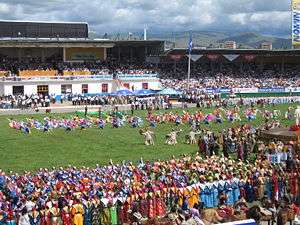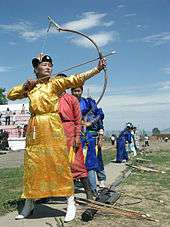Naadam

Naadam (Mongolian: Наадам, classical Mongolian: Naɣadum, [ˈnaːdəm], literally "games") is a traditional festival in Mongolia. The festival is also locally termed "eriin gurvan naadam" (эрийн гурван наадам) "the three games of men". The games are Mongolian wrestling, horse racing, and archery, and are held throughout the country during midsummer. Women have started participating in the archery and girls in the horse-racing games, but not in Mongolian wrestling.
In 2010, Naadam was inscribed on the Representative List of the Intangible Cultural Heritage of Humanity of UNESCO.
Overview
Naadam is the most widely watched festival among Mongols, and is believed to have existed for centuries in one fashion or another. Naadam has its origin in the activities, such as military parades and sporting competitions such as archery, horse riding and wrestling, that followed the celebration of various occasions, including weddings or spiritual gatherings. It later served as a way to train soldiers for battle. The three games of wrestling, horse racing and archery had been recorded in the 13rd century book The Secret History of the Mongols. During the Qing's rule, Naadam became an festival officially held by sums. Now it formally commemorates the 1921 Revolution when Mongolia declared itself independent of China. Naadam also celebrates the achievements of the new state.[1] Naadam was celebrated as a Buddhist/shaman holiday until secularization in the 1930s under the communist influence of the Soviet Union.
In Mongolia, the biggest festival (National Naadam) is held in the Mongolian capital Ulaanbaatar during the National Holiday from July 11 – 13, in the National Sports Stadium. Naadam begins with an elaborate introduction ceremony featuring dancers, athletes, horse riders, and musicians. After the ceremony, the competitions begin. The competitions are mainly horseback riding. Naadam is also organized in different regions of Mongolia and Inner Mongolia in July and August. In the Tuva Republic, Naadam is held officially in 15 August.
The three sports are called "Danshig" games. They became the great celebration of the new nation, where the nobility got together to dedicate to the Jabzundamba Khutugtu, the new head of state.[1]
Genghis Khan's nine horse tails, representing the nine tribes of the Mongols, are still ceremonially transported from Sukhbaatar Square to the Stadium to open the Naadam festivities. At these opening and closing ceremonies, there are impressive parades of mounted cavalry, athletes and monks.
Another popular Naadam activity is the playing of games using shagai, sheep anklebones that serve as game pieces and tokens of both divination and friendship. In the larger Nadaam festivals, tournaments may take place in a separate venue.
Three games
Wrestling

A total of 512 or 1024 wrestlers meet in a single-elimination tournament that lasts nine or ten rounds. Mongolian traditional wrestling is an untimed competition in which wrestlers lose if they touch the ground with any part of their body other than their feet or hands. When picking pairs, the wrestler with the greatest fame has the privilege to choose his opponent. Wrestlers wear two-piece costumes consisting of a tight shoulder vest (zodog) and shorts (shuudag). Only men are allowed to participate.
Each wrestler has an "encourager" called a zasuul. The zasuul sings a song of praise for the winning wrestler after rounds 3, 5, and 7. Winners of the 7th or 8th stage (depending on whether the competition features 512 or 1024 wrestlers) earn the title of zaan, "elephant". The winner of the 9th or 10th stage, is called arslan, "lion".[2] In the final competition, all the "zasuuls" drop in the wake of each wrestler as they take steps toward each other. Two-time arslans are called the titans / giants, or avraga.[2]
Horse racing
Unlike Western horse racing, which consists of short sprints generally not much longer than 2 km, Mongolian horse racing as featured in Naadam is a cross-country event, with races 15–30 km long. The length of each race is determined by age class. For example, two-year-old horses race for ten miles and seven-year-olds for seventeen miles. Up to 1000 horses from any part of Mongolia can be chosen to participate. Race horses are fed a special diet.
Children from 5 to 13 are chosen as jockeys and train in the months preceding the races. While jockeys are an important component, the main purpose of the races is to test the skill of the horses.[3]
Before the races begin, the audience sings traditional songs and the jockeys sing a song called Gingo. Prizes are awarded to horses and jockeys. The top five horses in each class earn the title of airgiyn tav and the top three are given gold, silver, and bronze medals. The winning jockey is praised with the title of tumny ekh or leader of ten thousand. The horse that finishes last in the Daaga race (two-year-old horses race) is called bayan khodood (meaning "full stomach"). A song is sung to the Bayan khodood wishing him luck to be next year's winner.[3]
 Riders in Mongolia during Naadam festival.
Riders in Mongolia during Naadam festival. Rider during Naadam, in Mongolia.
Rider during Naadam, in Mongolia. Two young riders race across the finish line
Two young riders race across the finish line
Archery

In this competition both men and women may participate. It is played by teams of ten. Each archer is given four arrows; the team must hit 33 "surs". Men shoot their arrows from 75 meters away while women shoot theirs from 65 meters away. Traditionally the archers wear their national clothing (Deel) during the competition. All the archers wear leather bracers up to the elbow on their outstretched arm, so that the deel’s cuff does not interfere with shooting.
Mongolian archery is unique for having dozens of surs as targets. Each sur is a small woven or wooden cylinder. They are placed one on top another forming a wall three-high, which is approximately 8 inches high by 5 feet wide. Knocking a sur out of the wall with an arrow counts as a hit, though knocking a sur out of the centre will bring a competitor more points. When the archer hits the target, the judge says uuhai which means "hooray". After each hit, an official repairs the damaged wall and makes it ready for the next attempt. The winners of the contest are granted the titles of "national marksman" and "national markswoman".[4]
See also
- Tsagaan Sar (English "White Month"), the Mongolian Lunar New Year (the first most important Mongolian holiday before Naadam).
References
- 1 2 Atwood Christopher Pratt, 1964-Encyclopedia of Mongolia and the Mongol Empire, Facts On File, Ink
- 1 2 "The Maulers of Mongolia", Black Belt magazine, July 1969, p. 22
- 1 2 "Naadam Festival." The Center for the Study . 16 Apr 2008 <http://www.csen.org/Mongol.Nadaam/Mongol.text.html
- ↑
External links
| Wikimedia Commons has media related to Naadam. |
- Chinggis Khaan's Mongolia. S. Uranbileg and E. Amarbilig. Ulaanbaatar, 2006, 156 p. ISBN 99929-65-08-8. In English.
- Naadam Festival, The Center for the Study of Eurasian Nomads
- Naadam Festival Blog- Mongolia Naadam Festival
- Audio coverage of horse racing
- Interview with Australian adventurer Tim Cope on his journey in the footsteps of Genghis Khan by horse and the Naadam Festival
